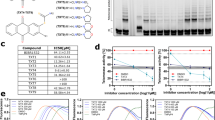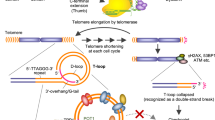Abstract
The telomerase complex is responsible for telomere maintenance and represents a promising neoplasia therapeutic target. In order to determine whether G-quadruplex-interactive telomerase inhibitor, telomestatin (SOT-095), might have effects on telomere dynamics and to evaluate the clinical utility, we assessed the effects of telomestatin on BCR-ABL-positive human leukemia cells. We found that treatment with telomestatin reproducibly inhibited telomerase activity in the BCR-ABL-positive leukemic cell lines OM9;22 and K562, resulting in telomere shortening. Inhibition of telomerase activity by telomestatin disrupts telomere maintenance and ultimately results in telomere dysfunction. Telomestatin completely suppressed the plating efficiency of K562 cells at 1 μ M; however, telomestatin had less effects on BFU-Es and CFU-GMs colony formation from normal bone marrow CD34-positive cells. Enhanced chemosensitivity toward imatinib and chemotherapeutic agents was also observed in telomestatin-treated K562 cells. Further, the combination of telomestatin plus imatinib more effectively inhibited hematopoietic colony formation by primary human chronic myelogenous leukemia cells. Last, telomestatin induced the activation of ATM and Chk2, and subsequently increased the expression of p21CIP1 and p27KIP1. These results demonstrate that telomere dysfunction induced by telomestatin activates the ATM-dependent DNA damage response. We conclude that telomerase inhibitors combined with the use of imatinib and other chemotherapeutic agents may be very useful for the treatment of human leukemia.
This is a preview of subscription content, access via your institution
Access options
Subscribe to this journal
Receive 50 print issues and online access
$259.00 per year
only $5.18 per issue
Buy this article
- Purchase on Springer Link
- Instant access to full article PDF
Prices may be subject to local taxes which are calculated during checkout







Similar content being viewed by others
References
Bearss DJ, Hurley LH and Von Hoff DD . (2000). Oncogene, 19, 6632–6641.
Blackburn E and Greider C . (eds). (1995). Telomeres, Cold Spring Harbor Laboratory Press: New York.
Blasco MA, Gasser SM and Linger J . (1999). Genes Dev., 13, 2353–2359.
Brown AL, Lee CH, Schwarz JK, Mitiku N, Piwnica-Worms H and Chung JH . (1999). Proc. Natl. Acad. Sci. USA, 96, 3745–3750.
Bryan TM, Englezou A, Gupta J, Bacchetti S and Reddel RR . (1995). EMBO J., 14, 4240–4248.
Chaturvedi P, Eng WK, Zhu Y, Mattern M, Mishra R, Hurle MR, Zhang Z, Annan RS, Lu Q, Faucette LF, Scott GF, Li X, Carr SA, Johson RK, Winkler JD and Zhou BBS . (1999). Oncogene, 18, 4047–4054.
Chaves-Dias C, Hundley TR, Gilfillan AM, Kirshenbaum AS, Cunha-Melo JR, Metcalf DD and Beaven MA . (2001). J. Immunol., 166, 6647–6656.
Chehab NH, Malikzay A, Appel M and Halazonetis TD . (2000). Genes Dev., 14, 278–288.
Damm K, Hemmann U, Garin-Chesa P, Hauel N, Kauffmann I, Priepke H, Niestroj C, Daiber C, Enenkel B, Guilliard B, Lauritsch I, Muller E, Pascolo E, Sauter G, Pantic M, Martens UM, Wenz C, Lingner J, Kraut N, Rettig WJ and Schnapp A . (2001). EMBO J., 20, 6958–6968.
Delhommeau F, Thierry A, Feneux D, Lauret E, Leclercq E, Courtier MH, Sainteny F, Vainchenker W and Bennaceur-Griscelli A . (2002). Oncogene, 21, 8262–8271.
de Lange T and Jacks T . (1999). Cell, 98, 273–275.
Druker BJ, Resta DJ, Peng B, Buchdunger E, Ford JM, Capdeville R and Tarpaz M . (2001). N. Engl. J. Med., 344, 1031–1037.
Druker BJ, Tamura S, Buchdunger E, Ohno S, Segal GM, Fanning S, Zimmermann J and Lydon NB . (1996). Nat. Med., 2, 561–566.
Dunham MA, Neumann AA, Fasching CL and Reddel RR . (2000). Nat. Genet., 4, 447–450.
Glukhov AI, Zimnik OV, Gordeev SA and Severin SE . (1998). Biochem. Biophys. Res. Commun., 248, 368–371.
Gorre ME, Mohammed M, Ellwood K, Hsu N, Paquette R, Rao PN and Sawyers CL . (2001). Science, 293, 876–880.
Guiducci C, Cerone MA and Bacchetti S . (2001). Oncogene, 20, 714–725.
Hahn WC, Stewart SA, Brooks MW, York SG, Eaton E, Kurachi A, Beijersbergen RL, Knoll JHM, Meyerson M and Weinberg RA . (1999). Nat. Med., 5, 1164–1170.
Harley CB . (1991). Mutat. Res., 256, 271–282.
Hirano A, Kong YY, Matuoka S, Wakeham A, Ruland J, Yoshida H, Liu D, Elledge SJ and Mak TW . (2000). Science, 287, 1824–1827.
Hisatomi H, Nagao K, Kanamaru T, Endo H, Tomimatsu M and Hikiji K . (1999). Int. J. Oncol., 14, 727–732.
Izbicka E, Wheelhouse RT, Raymond E, Davidson KL, Lawrence RA, Sun D, Windle BE, Hurley LH and Von Hoff DD . (1999). Cancer Res., 59, 639–644.
Kharbanda S, Kumar V, Dhar S, Pandey P, Chen C, Majumder P, Yuan ZM, Whang Y, Strauss W, Pandita TK, Weaver D and Kufe D . (2000). Curr. Biol., 10, 568–575.
Kim MS, Rivera M, Botchkina I, Shalaby R, Thor AD and Blackburn EH . (2001). Proc. Natl. Acad. Sci. USA, 98, 7982–7987.
Kim MY, Vankayalapati H, Shin-ya K and Hurley LH . (2002). J. Am. Chem. Soc., 123, 1262–1263.
Kondo S, Kondo Y, Li G, Silverman RH and Cowell JK . (1998). Oncogene, 16, 3323–3330.
Lavin MF and Shiloh Y . (1997). Annu. Rev. Immunol., 15, 177–202.
Lee KH, Rudolph KL, Ju YJ, Greenberg RA, Cannizzaro L, Chin L, Weiler SR and DePinho RA . (2001). Proc. Natl. Acad. Sci. USA, 98, 3381–3386.
Liu JP . (1999). FASEB J., 13, 2091–2104.
Meyerson M . (2000). J. Clin. Oncol., 18, 2626–2634.
Nakajima A, Tauchi T and Ohyashiki K . (2001). Leukemia, 15, 989–990.
Nakajima A, Tauchi T, Sashida G, Sumi M, Abe K, Yamamoto K, Ohyashiki JH and Ohyashiki K . (2003). Leukemia, 17, 560–567.
Ohyashiki K, Miyauchi J, Ohyashiki JH, Saito M, Yaguchi M, Inatomi Y, Nakazawa S, Wada H, Mizutani S, Matsuo Y, Minowada J and Toyama K . (1993). Leukemia, 7, 1034–1040.
Ohyashiki JH, Sashida G, Tauchi T and Ohyashiki K . (2002). Oncogene, 21, 680–687.
Perry PJ and Jenkins TC . (1999). Exp. Opin. Invest. Drugs, 8, 1981–2008.
Sachsinger J, Gonzalez-Suarez E, Samper E, Heicappell R, Muller M and Blasco MA . (2001). Cancer Res., 61, 5580–5586.
Savitsky K, Bar-Shira A, Gilad S, Rotman G, Ziv Y, Vanagaite L, Tagle DA, Smith S, Uziel T, Sfez S, Ashkenazi M, Pecker I, Frydman M, Harnik R, Patanjali SR, Simmons A, Clines GA, Sartiel A, Gatti RA, Chessa L, Sanal O, Lavin MF, Jaspers NG, Taylor AMR, Arlett CF, Miki T, Weissman SM, Lovett M, Collins FS and Shiloh Y . (1995). Science, 268, 1749–1753.
Sawyers CL, McLauglin J, Goga A, Havlik M and Witte ON . (1994). Cell, 77, 121–131.
Shi DN, Wheelhouse RT, Sun D and Hurley LH . (2001). J. Med. Chem., 44, 4509–4523.
Shieh SY, Ahn J, Tamai K, Taya Y and Prives C . (2000). Genes Dev., 14, 289–300.
Shin-ya K, Wierzba K, Matsuo K, Ohtani T, Yamada Y, Furihata K, Hayakawa Y and Seto H . (2001). J. Am. Chem. Soc., 123, 1262–1263.
Sun D, Thompson B, Cathers BE, Salazar M, Kerwin S, Trent JO, Jenkins TC, Niedle S and Hurley LH . (1997). J. Med. Chem., 40, 2113–2116.
Tauchi T, Feng GS, Shen R, Song HY, Donner D, Pawson T and Broxmeyer HE . (1994). J. Biol. Chem., 269, 15381–15387.
Tauchi T, Nakajima A, Sashida G, Shimamoto T, Ohyashiki JH, Abe K, Yamamoto K and Ohyashiki K . (2002). Clin. Cancer Res., 8, 3341–3347.
van Steensel B, Smogorzewska A and de Lange T . (1998). Cell, 92, 401–413.
Wheelhouse TR, Sun D, Han H, Han F and Hurley LH . (1998). J. Am. Chem. Soc., 120, 3261–3262.
Zahler AM, Williamson JR, Cech TRR and Prescotte DM . (1991). Nature, 350, 718–720.
Zhang X, Mar V, Zhou W, Harrington L and Robinson MO . (1999). Genes Dev., 13, 2388–2399.
Acknowledgements
This work was supported by a grant-in-aid from the Ministry of Education, Science and Culture of Japan (to TT) and NOVARTIS Foundation for the Promotion of Science (to TT) and by the Promotion and Mutual Aid Corporation for Private School of Japan (to KO) and by the high-tech research center for intractable disease of Tokyo Medical University from the Ministry of Education, Culture, Sports, Science and Technology in Japan (to KO). We thank Hisashi Hisatomi (SRL, Inc.) for analysis of telomerase activity and hTERT expression.
Author information
Authors and Affiliations
Corresponding author
Rights and permissions
About this article
Cite this article
Tauchi, T., Shin-ya, K., Sashida, G. et al. Activity of a novel G-quadruplex-interactive telomerase inhibitor, telomestatin (SOT-095), against human leukemia cells: involvement of ATM-dependent DNA damage response pathways. Oncogene 22, 5338–5347 (2003). https://doi.org/10.1038/sj.onc.1206833
Received:
Revised:
Accepted:
Published:
Issue Date:
DOI: https://doi.org/10.1038/sj.onc.1206833
Keywords
This article is cited by
-
QSAR, pharmacophore modeling and molecular docking studies to identify structural alerts for some nitrogen heterocycles as dual inhibitor of telomerase reverse transcriptase and human telomeric G-quadruplex DNA
Future Journal of Pharmaceutical Sciences (2021)
-
BG-flow, a new flow cytometry tool for G-quadruplex quantification in fixed cells
BMC Biology (2021)
-
G-quadruplexes: a promising target for cancer therapy
Molecular Cancer (2021)
-
Chemical targeting of G-quadruplexes in telomeres and beyond for molecular cancer therapeutics
The Journal of Antibiotics (2021)
-
The role of telomeres and telomerase in cirrhosis and liver cancer
Nature Reviews Gastroenterology & Hepatology (2019)



